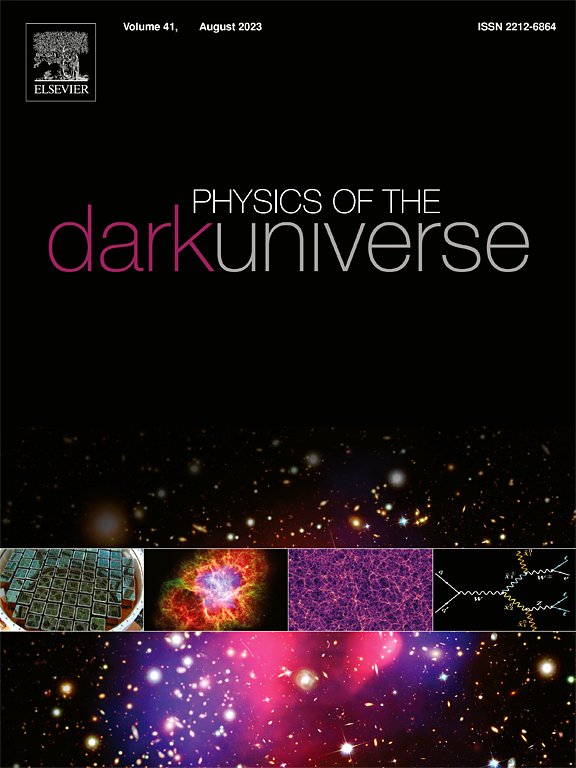Kalb-Ramond ModMax黑洞中的粒子动力学和热性质:奇异物理观测测试的理论预测
IF 6.4
2区 物理与天体物理
Q1 ASTRONOMY & ASTROPHYSICS
引用次数: 0
摘要
本文对基于ModMax电动力学的Kalb-Ramond (KR)黑洞(BH)时空中的测地线运动和热力学行为进行了全面的理论研究。研究了中性和带电测试粒子动力学,突出了洛伦兹对称破断(LSB)参数r, ModMax非线性参数γ和离散分支参数ζ与经典史瓦西和Reissner-Nordström (RN)解相比如何显著改变轨道结构。有效的势能分析揭示了最内层稳定圆轨道(ISCO)的显著变化:普通分支允许稳定轨道更接近视界,而幻影分支将它们向外移动5-10倍。对于带电粒子,修正重力和非线性电磁场的共同影响可能在某些情况下诱发混沌轨迹。在热力学方面,我们导出了霍金温度、熵和亥姆霍兹自由能的完整表达式。普通分支表现出发散的比热,表明二级相变,而幻形分支始终产生负比热,意味着热不稳定性。幻影黑洞被发现具有更高的霍金温度,并显示出不同的热力学相结构,包括霍金页型转变。研究了黑洞阴影和引力透镜等观测特征,揭示了光子球半径和偏转角的参数依赖变化。值得注意的是,通过高斯-邦纳定理方法(GBTm)进行的偏转角分析显示,幻形分支与普通分支的电磁修正符号相反,这表明存在潜在的观测区别。本文章由计算机程序翻译,如有差异,请以英文原文为准。
Particle dynamics and thermal properties in Kalb–Ramond ModMax black holes: Theoretical predictions for observational tests of exotic physics
We present a comprehensive theoretical study of geodesic motion and thermodynamic behavior in Kalb–Ramond (KR) black hole (BH) spacetimes sourced by ModMax electrodynamics. Both neutral and charged test particle dynamics are investigated, highlighting how the Lorentz symmetry breaking (LSB) parameter , the ModMax nonlinearity parameter , and the discrete branch parameter significantly modify orbital structures compared to classical Schwarzschild and Reissner–Nordström (RN) solutions. Effective potential analysis reveals notable shifts in the innermost stable circular orbit (ISCO): ordinary branches allow stable orbits closer to the horizon, while phantom branches shift them outward by factors of 5–10. For charged particles, the combined influence of modified gravity and nonlinear electromagnetic fields may induce chaotic trajectories in certain regimes. On the thermodynamic side, we derive full expressions for Hawking temperature, entropy, and Helmholtz free energy. Ordinary branches exhibit divergent specific heat indicating second-order phase transitions, whereas phantom branches yield consistently negative specific heat, implying thermal instability. Phantom BHs are found to possess higher Hawking temperatures and show distinct thermodynamic phase structures, including Hawking–Page-type transitions. Observational features such as BH shadows and gravitational lensing are explored, revealing parameter-dependent changes in photon sphere radii and deflection angles. Notably, the deflection angle analysis via the Gauss–Bonnet theorem method (GBTm) shows opposite-sign electromagnetic corrections for phantom versus ordinary branches, suggesting potential observational discriminants.
求助全文
通过发布文献求助,成功后即可免费获取论文全文。
去求助
来源期刊

Physics of the Dark Universe
ASTRONOMY & ASTROPHYSICS-
CiteScore
9.60
自引率
7.30%
发文量
118
审稿时长
61 days
期刊介绍:
Physics of the Dark Universe is an innovative online-only journal that offers rapid publication of peer-reviewed, original research articles considered of high scientific impact.
The journal is focused on the understanding of Dark Matter, Dark Energy, Early Universe, gravitational waves and neutrinos, covering all theoretical, experimental and phenomenological aspects.
 求助内容:
求助内容: 应助结果提醒方式:
应助结果提醒方式:


